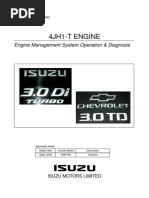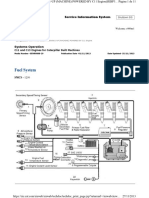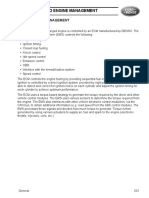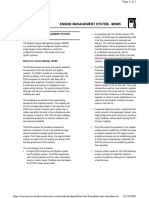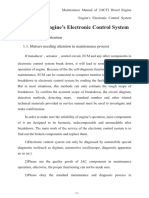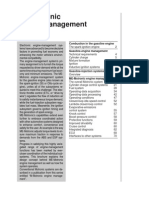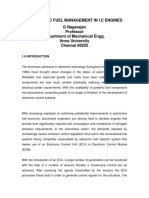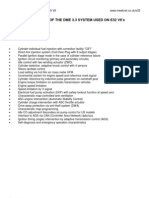M138 Engine Specifications
M138 Engine Specifications
Uploaded by
WyattCopyright:
Available Formats
M138 Engine Specifications
M138 Engine Specifications
Uploaded by
WyattOriginal Description:
Copyright
Available Formats
Share this document
Did you find this document useful?
Is this content inappropriate?
Copyright:
Available Formats
M138 Engine Specifications
M138 Engine Specifications
Uploaded by
WyattCopyright:
Available Formats
1 ENGINE
1.1 TECHNICAL SPECIFICATIONS
Cylinders 8-90°V
Bore 92 mm
Stroke 79,8 mm
Piston displacement 530,479 cm3
Total displacement 4243,83 cm3
Compression ratio 11,107 ± 0,2 : 1
Max power. 287 kw
Corresponding rpm 7000 min-1
Max torque 448 Nm
Corresponding rpm 4500 min-1
1.1.1 General information
Cylinder heads in hardened aluminium/silicium alloy with high volumetric and thermodynamic effi-
ciency combustion chamber.
Crankcase in hardened aluminium/silicium alloy with fitted steel cylinder liners.
Single-cast crankshaft in hardened steel, individually balanced, resting on five journals with bearings.
The engine is equipped with an integrated ignition/injection system (Bosch ME7.3.2).
The timing system uses four overhead camshafts (two per bank) and four valves per cylinder, driven
by hydraulic self-adjusting buckets.
The intake camshafts are equipped with a continuous high-pressure timing variator which has a spe-
cific pump and is controlled by the injection ECU, via a solenoid valve. This system enables varying the
timing of the intake valves, as required by the engine's running conditions.
The timing system is controlled by two chains whose tension is determined by hydraulic tensioners.
Engine lubrication is the dry-sump type with a delivery and scavenge pump aligned with the cooling
pump and integrated in a single unit , controlled by the crankshaft via a chain.
Engine cooling is obtained by means of an anti-freeze coolant.
PRESENTAZIONE TECNICA PROGETTO M138 5
ENGINE
TECHNICAL SPECIFICATIONS
FRONT SIDE 1
SIDE 2 REAR
TOP
6 PRESENTAZIONE TECNICA PROGETTO M138
ENGINE
INJECTION/IGNITION SYSTEM
1.2 INJECTION/IGNITION SYSTEM
1.2.1 Specifications
Injection
Type: Bosch ME7.3.2
Electronic Control Unit Bosch A 261 203
939
Ignition
Static ignition
Ignition sequence: 1-8-6-2-7-3-4-5
Ignition coil: Bosch A 221 630
021
Spark plugs: NGK PMR8A
1.2.2 General information
The ignition and injection system installed in the car is controlled by a single microprocessor Control
Unit (ECU).
This optimises both the engine performance and handling of the vehicle, as well as reducing fuel con-
sumption by optimising engine running with partial loads.
The system includes the following components:
• ELECTRIC/ELECTRONIC system
• AIR INTAKE system
• FUEL SUPPLY system
• EMISSION CONTROL system
• EXHAUST TEMPERATURE CONTROL system.
The system uses the following signals coming from external sensors:
• engine rpm and position (with respect to the T.D.C.);
• intake air volume and temperature;
• throttle position and opening speed;
• accelerator pedal position;
• coolant temperature;
• catalytic converter internal temperature;
• mixture ratio;
• knocking detection;
• car speed;
• ignition key to ON;
• battery voltage;
• brake system operation;
• clutch operation;
• turbocompressor activation;
• A/C system activation;
• engine supply cut-out;
• parameters coming from other systems over the CAN line (ABS, ASR, Electronically controlled gear-
box, etc.).
PRESENTAZIONE TECNICA PROGETTO M138 7
ENGINE
INJECTION/IGNITION SYSTEM
1.2.3 System description
The two engine banks use individual ignition coils controlled by the microprocessor ECU. The latter
receives signals regarding the vehicle's running conditions from the engine sensors and directly oper-
ates the actuators which control the engine itself.
The ECUs communicate with the other on-board systems over the CAN (Controller Area Network) line
to optimise engine management.
The system is thus composed mainly of the ECU and a set of sensors and actuators.
4 5 2 7 12 1
13
3
2 4
6
10
5 3 10
9 11 14
1) Control unit (ECU)
2) Electro-injectors
3) Ignition coils
4) Coil connectors to engine wiring
5) Timing variators
6) Knocking sensors
7) Timing sensors
8) Water temperature sensors
9) Front Lambda sensor connectors
10) Rear Lambda sensor connectors
11) Throttle body
12) Oil pressure sensor
13) RPM sensor
14) Air flow meter
8 PRESENTAZIONE TECNICA PROGETTO M138
ENGINE
INJECTION/IGNITION SYSTEM
These components, together with the ECU, provide the MOTRONIC ME7.3.2 system with the following
specifications:
• EGAS (Electronic GAS Pedal).
An engine control system in which every situation is interpreted as a torque demand. The main ele-
ment in torque demand is represented by the accelerator pedal.
• OBD II (On Board Detection and Diagnostic system)
A system which detects operational malfunctions inside the engine control system, in order to ensure
compliance with emissions control standards.
• RLFS (Return Less Fuel System)
Fuel supply system preventing fuel return to the tank.
PRESENTAZIONE TECNICA PROGETTO M138 9
ENGINE
FUEL SYSTEM
1.3 FUEL SYSTEM
1.3.1 Air intake system
Outside air enters the air inlet (1), beneath the front bumpers, and is directed to the filter cartridges
(2).
The filtered air flow reaches the air-flow meter(3), which informs the ECU on the quantity of air taken
in. The air is then delivered to the plenum chamber (7).
Connected to the air flow meter by a pipe (5) is the motor-driven throttle body (6) whose opening is
electrically controlled by the ECU.
The so metered air flow enters the plenum chamber (7) where it is divided and conveyed to the intake
manifold to be mixed then with the fuel.
7
6 5
4 3
2
1
1) Air inlet
2) Air filter
3) Air flow meter
4) Conveyor-Resonator
5) Air Flow Meter /Throttle body duct
6) Throttle body
7) Plenum chamber
10 PRESENTAZIONE TECNICA PROGETTO M138
ENGINE
FUEL SYSTEM
1.3.2 Fuel supply system
Each egine bank is supplied by its own fuel system from the common fuel tank (1).
Each system is composed of an electric pump (2) fitted inside the fuel tank.
From the pump, the fuel is conveyed to the delivery pipe/injector rail(3) which delivers the fuel to the
injectors (4) on each bank.
The system is of the “returnless” type, that is without fuel return to the tank. This is ensured by the
three float valves (5) which prevent fuel from spilling under particular set-up conditions of the vehicle.
The tank has a decanter in the upper section (6) which collects and condenses the fuel vapours.
Besides these valves, the system includes an inertia switch which cuts off power to the fuel pumps
when the vehicle is subject to violent decelerations (collisions).
The tank also has a controller which tansmits the signal to the fuel level indicator on the dashboard.
5 6 1
4 2
1) Fuel tank
2) Electric pumps
3) Delivery pipes/injector rail
4) Injectors
5) Float valves
6) Decanter
PRESENTAZIONE TECNICA PROGETTO M138 11
ENGINE
ANTI-POLLUTION SYSTEMS
1.4 ANTI-POLLUTION SYSTEMS
1.4.1 Fuel vapour emission system
The evaporation monitoring system is designed to prevent fuel vapours from leaking out of the fuel
circuit.
The vapours coming from the tank (1) are conveyed to a decanter (2) where one part condenses and
falls back into the tank, while another part reaches the three float valves (3) which prevent fuel spill-
ing in case of vehicle rolling.
The roll-over shut off valves deliver the vapour to the active charcoal filter (4) which absorbs and re-
tains them, when the engine is at rest.
The active charcoal filter output unions are connected to the plenum chamber(5) via a pipe (6) con-
trolled by a solenoid valve (7).
The ambient air intake on the filter is operated by a roll-over shut off valve (8). The active charcoal
filter takes in not only the air but also the fuel vapours which are then delivered to the plenum cham-
ber.
5 7 1 2 4 8
6 3
1) Tank
2) Decanter
3) Float valves
4) Active charcoal filter
5) Plenum chamber
6) Piping
7) Solenoid valve
8) Roll-over shut off valves
12 PRESENTAZIONE TECNICA PROGETTO M138
ENGINE
ANTI-POLLUTION SYSTEMS
1.4.2 Secondary air system
This system delivers additional air to the exhaust manifolds in order to reduce the HC and CO emis-
sions during the catalytic converter heating stage.
The solenoid valve (1) is controlled by the ECU to open/close the two pneumatic valves (2) which ac-
tuate the injection of secondary air into the exhaust manifolds.
The vacuum tank (3), located beneath the LH wheelhouse, is connected to the solenoid valve via the
pipe (4), and to the plenum chamber via the duct (5).
The solenoid valve, which controls additional air delivery, is connected to the pneumatic valves by
means of a three-way union.
The pneumatic valves send the air to the exhaust manifolds via the pipes (6) using the secondary air
pump (7), which is controlled by the ECU to take air from a filter in order to reduce the hydrocarbon
content of the exhaust gases.
The pump and the secondary air solenoid valve are activated, after engine ignition, when the coolant
temperature is in the range -10° C to - 40° C.
The function is active for around 80 seconds, de-activates for around 60 seconds and then re-acti-
vates for a further 10 seconds.
In the latter period the secondary air valve seal is monitored.
The Lambda sensors are inhibited during this entire cycle .
6 1
7 3
5
8 6
1) Solenoid valve
2) Pneumatic valves
3) Vacuum tank
4) Tank/valve pipe
5) Tank/plenum chamber duct
6) Exhaust manifold pipes
7) Exhaust manifolds
8) Secondary air pump
PRESENTAZIONE TECNICA PROGETTO M138 13
ENGINE
ANTI-POLLUTION SYSTEMS
1.4.3 Emission control system
The exhaust gases leaving each head are delivered by a manifold (1) into the respective catalytic con-
verter (pre-catalytic converter) (2).
The pre-catalytic converter reduces the emissions of HC, CO and NOx into the atmosphere.
Each pre-catalytic converter is fitted (upstream and downstream) with two lambda sensors (3 and 4)
which monitor the oxygen content of the exhaust gas. The lambda sensor output signal
is sent to the ECU which controls the air/fuel mixture strength to maintain the stoichiometric ratio as
close as possible to the theoretical value.
Downstream of the pre-catalytic converters are two further catalytic converters (5) (one per branch),
equipped with thermocouples (6) which send the temperature signal to the ECU.
In case of incorrect operation of the engine and consequent exhaust system overheating, the ECU
sends a signal to the multi-function display which lights up the SLOW DOWN icon.
The exhaust gases are delivered from the catalytic converters to the pre-silencers (7) and are then con-
veyed into the atmosphere through the silencers (8).
2 4 4 5 7 8
1 3 2 1 4 6
1) Manifolds
2) Pre-catalytic converters
3) Upstream Lambda sensors
4) Downtream Lambda sensors
5) Catalytic converters
6) Thermocouples
7) Pre-silencers
8) Silencers
14 PRESENTAZIONE TECNICA PROGETTO M138
You might also like
- UNIT7L1 - 2S - Electronically Controlled Fuel SystemsNo ratings yetUNIT7L1 - 2S - Electronically Controlled Fuel Systems10 pages
- C9_ ACERT™ _ Engine Manual _ CATERPILLAR®-1No ratings yetC9_ ACERT™ _ Engine Manual _ CATERPILLAR®-147 pages
- 1.5VCT Engine Management System and Engine Mechanical2No ratings yet1.5VCT Engine Management System and Engine Mechanical2149 pages
- Modular Engine Management System OperationNo ratings yetModular Engine Management System Operation2 pages
- Engine Electronic Electric Sys Engine Electronic Control SysteNo ratings yetEngine Electronic Electric Sys Engine Electronic Control Syste89 pages
- The Engine Management System For Gasoline EnginesNo ratings yetThe Engine Management System For Gasoline Engines17 pages
- Electronic Fuel Management in I.C Engines G Nagarajan Professor Department of Mechanical Engg. Anna University Chennai 60025No ratings yetElectronic Fuel Management in I.C Engines G Nagarajan Professor Department of Mechanical Engg. Anna University Chennai 600255 pages
- Unit 7: Electronically Controlled Fuel SystemsNo ratings yetUnit 7: Electronically Controlled Fuel Systems8 pages
- 4.3.1general Description: 4.3 DA471QLR Engine SeriesNo ratings yet4.3.1general Description: 4.3 DA471QLR Engine Series35 pages
- C27 and C32 Generator Set Engines - PDF Versión 1No ratings yetC27 and C32 Generator Set Engines - PDF Versión 19 pages
- Description of The Dme 3.3 System Used On E32 V8'SNo ratings yetDescription of The Dme 3.3 System Used On E32 V8'S9 pages
- 4.1 Engine Management System-R1-1 MINYI EFFANo ratings yet4.1 Engine Management System-R1-1 MINYI EFFA24 pages
- Model Predictive Control of High Power Converters and Industrial DrivesFrom EverandModel Predictive Control of High Power Converters and Industrial DrivesNo ratings yet
- Rubber Union From Power Unit To F1 Oil Tank Campaign 161No ratings yetRubber Union From Power Unit To F1 Oil Tank Campaign 16117 pages
- Maserati Quick Release Clamp For Negative Battery TerminalNo ratings yetMaserati Quick Release Clamp For Negative Battery Terminal3 pages
- Wheel Alignment 2006 Maserati QuattroporteNo ratings yetWheel Alignment 2006 Maserati Quattroporte2 pages
- Maserati Gear Selection Position Table For Maserati F1 GearboxNo ratings yetMaserati Gear Selection Position Table For Maserati F1 Gearbox5 pages
- Maserati Engine Model Code and Timing InformationNo ratings yetMaserati Engine Model Code and Timing Information1 page
- ZF 6HP26 Transmission Parts List and Car ModelsNo ratings yetZF 6HP26 Transmission Parts List and Car Models6 pages
- Maserati Service Campaign 373 Emissions Recall New ECU SoftwareNo ratings yetMaserati Service Campaign 373 Emissions Recall New ECU Software10 pages
- Maserati Bulletin MNA-22 Quattroporte M139 Key Programming ProcedureNo ratings yetMaserati Bulletin MNA-22 Quattroporte M139 Key Programming Procedure1 page
- 2011 Maserati GranTurismo MC Stradale Technical Presentation100% (1)2011 Maserati GranTurismo MC Stradale Technical Presentation58 pages
- Internship Presentation: DG Khan Cement Company - Khairpur PlantNo ratings yetInternship Presentation: DG Khan Cement Company - Khairpur Plant13 pages
- Para Oficina de Oir 04-Noviembre-2019: Marca Modelo Serie B.H.P. Combustible Tipo Fecha DE Fabricacion InstalacionNo ratings yetPara Oficina de Oir 04-Noviembre-2019: Marca Modelo Serie B.H.P. Combustible Tipo Fecha DE Fabricacion Instalacion49 pages
- GEP50-5 (3-Phase) : Diesel Generating SetNo ratings yetGEP50-5 (3-Phase) : Diesel Generating Set6 pages
- 1, Generator, AGC275SP-Specification - UnlockedNo ratings yet1, Generator, AGC275SP-Specification - Unlocked4 pages
- Pipe 55 CF 96 A 9550346 D 0338 CF 7 C 6No ratings yetPipe 55 CF 96 A 9550346 D 0338 CF 7 C 6488 pages
- SPECIFICATION ISUZU JE493DB-05 - UnlockedNo ratings yetSPECIFICATION ISUZU JE493DB-05 - Unlocked4 pages
- Example 4: Diesel Hammer Input: GRLWEAP Standard ExamplesNo ratings yetExample 4: Diesel Hammer Input: GRLWEAP Standard Examples3 pages
- Manual de Calibraciones Gen Kubota Series 0567% (3)Manual de Calibraciones Gen Kubota Series 05278 pages
- UNIT7L1 - 2S - Electronically Controlled Fuel SystemsUNIT7L1 - 2S - Electronically Controlled Fuel Systems
- 1.5VCT Engine Management System and Engine Mechanical21.5VCT Engine Management System and Engine Mechanical2
- Engine Electronic Electric Sys Engine Electronic Control SysteEngine Electronic Electric Sys Engine Electronic Control Syste
- Electronic Fuel Management in I.C Engines G Nagarajan Professor Department of Mechanical Engg. Anna University Chennai 60025Electronic Fuel Management in I.C Engines G Nagarajan Professor Department of Mechanical Engg. Anna University Chennai 60025
- 4.3.1general Description: 4.3 DA471QLR Engine Series4.3.1general Description: 4.3 DA471QLR Engine Series
- Description of The Dme 3.3 System Used On E32 V8'SDescription of The Dme 3.3 System Used On E32 V8'S
- Common Rail Fuel Injection Technology in Diesel EnginesFrom EverandCommon Rail Fuel Injection Technology in Diesel Engines
- Variable Speed AC Drives with Inverter Output FiltersFrom EverandVariable Speed AC Drives with Inverter Output Filters
- Automotive Electronic Diagnostics (Course 2)From EverandAutomotive Electronic Diagnostics (Course 2)
- Model Predictive Control of High Power Converters and Industrial DrivesFrom EverandModel Predictive Control of High Power Converters and Industrial Drives
- Rubber Union From Power Unit To F1 Oil Tank Campaign 161Rubber Union From Power Unit To F1 Oil Tank Campaign 161
- Maserati Quick Release Clamp For Negative Battery TerminalMaserati Quick Release Clamp For Negative Battery Terminal
- Maserati Gear Selection Position Table For Maserati F1 GearboxMaserati Gear Selection Position Table For Maserati F1 Gearbox
- Maserati Service Campaign 373 Emissions Recall New ECU SoftwareMaserati Service Campaign 373 Emissions Recall New ECU Software
- Maserati Bulletin MNA-22 Quattroporte M139 Key Programming ProcedureMaserati Bulletin MNA-22 Quattroporte M139 Key Programming Procedure
- 2011 Maserati GranTurismo MC Stradale Technical Presentation2011 Maserati GranTurismo MC Stradale Technical Presentation
- Internship Presentation: DG Khan Cement Company - Khairpur PlantInternship Presentation: DG Khan Cement Company - Khairpur Plant
- Para Oficina de Oir 04-Noviembre-2019: Marca Modelo Serie B.H.P. Combustible Tipo Fecha DE Fabricacion InstalacionPara Oficina de Oir 04-Noviembre-2019: Marca Modelo Serie B.H.P. Combustible Tipo Fecha DE Fabricacion Instalacion
- Example 4: Diesel Hammer Input: GRLWEAP Standard ExamplesExample 4: Diesel Hammer Input: GRLWEAP Standard Examples
